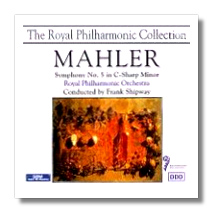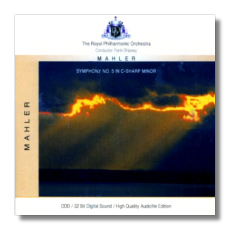
The Internet's Premier Classical Music Source
Related Links
- Mahler Reviews
- Latest Reviews
- More Reviews
-
By Composer
-
Collections
DVD & Blu-ray
Books
Concert Reviews
Articles/Interviews
Software
Audio
Search Amazon
Recommended Links
Site News
 CD Review
CD Review
Gustav Mahler

Symphony #5
Royal Philharmonic Orchestra/Frank Shipway
Tring TRP096
Also released on RPO 204494
Amazon - UK
- CD Universe
Also released on Hybrid Multichannel SACD on Membran 222845
Amazon - UK
- Germany
- France
- Japan
- CD Universe
Frank Shipway isn't the first conductor you think of as a Mahler interpreter. He may not be among the first conductors you think of, period. He's British and heads the National Symphony Orchestra of RAI in Italy and the BRNT Orchestra in Belgium. He's also an opera conductor which suggests a propensity for long-term planning.
Behind Shipway's Fifth seems to lie one overriding idea that he uses to hold the huge structure together to superb effect. The contrasting of opposites. Of course we've often said how much this work is about contrasts but Shipway seems to have decided he will make the illustration of them the "be all and end all" of his performance. So, every contrast that can be brought out is brought out, every opposing idea measured. It's an approach established from the start so it stays in the mind until the end .
In the first movement the funeral march proper has a huge, heavy tread while the quieter, reflective parts seem distanced: veiled, like the faces of the women mourners in the cortege. In fact there's something very 19th century about all this: dark, decaying a bit Gothic. Then, when the music calls for release, Shipway throws caution to the wind and goes for broke. This is a mood swing that will have you calling your analyst (Freudian, of course. This IS 19th-century Vienna, after all !) but it's one you have to get used to in this recording. He doesn't mould the themes in the way Bernstein does, doesn't "ham", there's no "drag" on the secondary theme of the funeral march, for example. It's extremes of dynamics and tempo that stay in the mind and this is carried over to the second movement.
How savagely the lower strings grind out the opening. Then that long, elegiac cello episode – like a confession – that leads back to the recall of the funeral march music is as withdrawn and soft as I have ever heard it and, again, veiled. Then, when Shipway presses forward again, we're back on a roller coaster, hanging on for dear life. We also realise the span from the start of the quiet cello section to the end of the chorale episode is a huge arc which, with the skill of an opera pit man, Shipway encompasses with ease. He does mould the chorale theme towards the end of the second movement very rhetorically, but by then I was too shell shocked and ready to ring up the white flag to protest.
The contrasts carry on in the Scherzo but their presentation is profoundly different. The main episodes themselves are taken very fast, challenging the orchestra who are a match for any in the world on this showing. But, as soon as the first Trio arrives, Shipway slows the tempo and dynamic right down to almost private contemplation. He appears to want to show us that polar opposing forces can coexist when not creating conflict. The horn obligato sections (with superb playing by John Bimson) I think anticipate the Seventh Symphony's Nachtmusik in being dark and dreamy with the darker colours accentuated. With all these contrasts duly brought out to the full, Shipway's scherzo is therefore not as sunny as we may be used to. There is a case to be made for the movement being more troubled and that's what Shipway gives us: the undertow is downward. There's certainly less of the Viennese lilt to the waltz episodes too and that may be a problem for some people.
As expected, the Adagietto is slow but when the music calls for intensity Shipway lets the strings have their heads and the way the violins dig into the bows reminds me of the Adagio from the Ninth symphony. The final descent at the end begins with an almost primal scream from the violins with a vast tone from the massed strings following. I'm not sure this "on the edge of despair" is what Mahler intended but it's still in keeping with the Shipway approach.
It's in the last movement that the opposites at last resolve themselves and, with no contrasts to be marked, conflict ceases. Shipway plays this movement as a carefree, jaunty romp. Fast also: at 14.30 just seconds short of Walter's speed. When the Adagietto music returns it's transformed from how we remembered it. Now it's light and joyous, a remarkable metamorphosis. Likewise the triumphant return of the chorale. No attempt at moulding the theme this time. It's played straight, straight from the heart, with ringing trumpets. There seems no doubt in Shipway's mind this work ends in unequivocal triumph. The biggest contrast of all is therefore the end of the symphony when compared with the beginning. I found myself smiling a lot during this last movement under Shipway – the feelgood factor !
The recording is big and bold to cope with Shipway's conception. It seems to fill out to meet his demands. The acoustic of Watford Coliseum (a new one on me) certainly gives a large sound picture with the horns especially caught well. Shipway seems to be in love with the sound of this symphony, luxuriating in it at times.
Shipway's Fifth isn't one for the everyday, but it's certainly one for the collection. One thing I guarantee: no Mahlerian will feel neutral about it. Either you'll love it on first hearing or you'll never want to hear it again. It isn't an easy option, but, so far as I'm concerned, it's brought me that bit closer to the piece. Another piece in the jigsaw of its performing tradition.
I don't know how easy Tring releases are to obtain outside the UK but I hope Shipway records more Mahler for them. They retail at the same price as Naxos, so a cycle by him on this label would knock the Naxos cycle out of the park.
Copyright © 1999, Tony Duggan




















